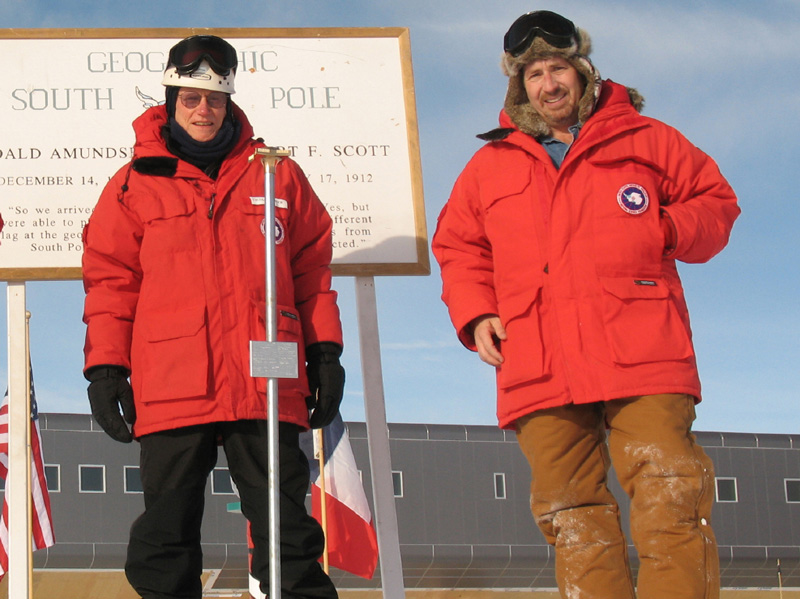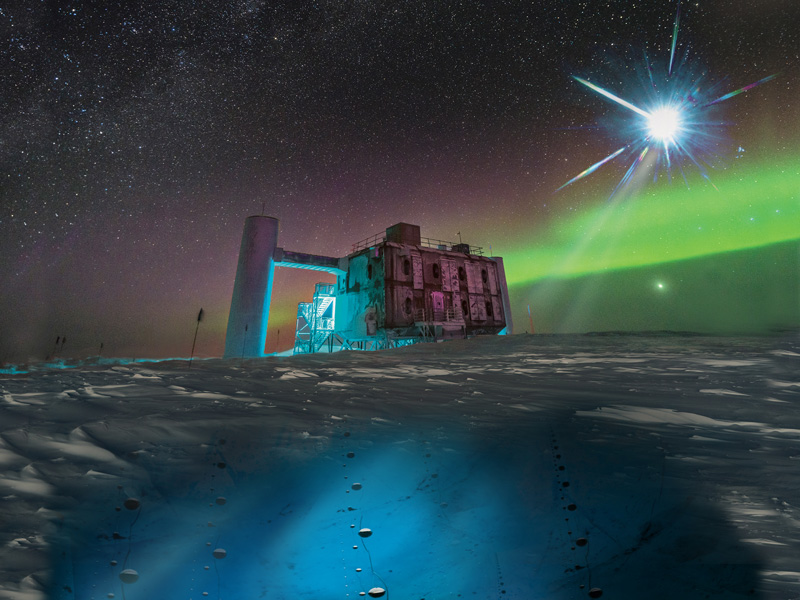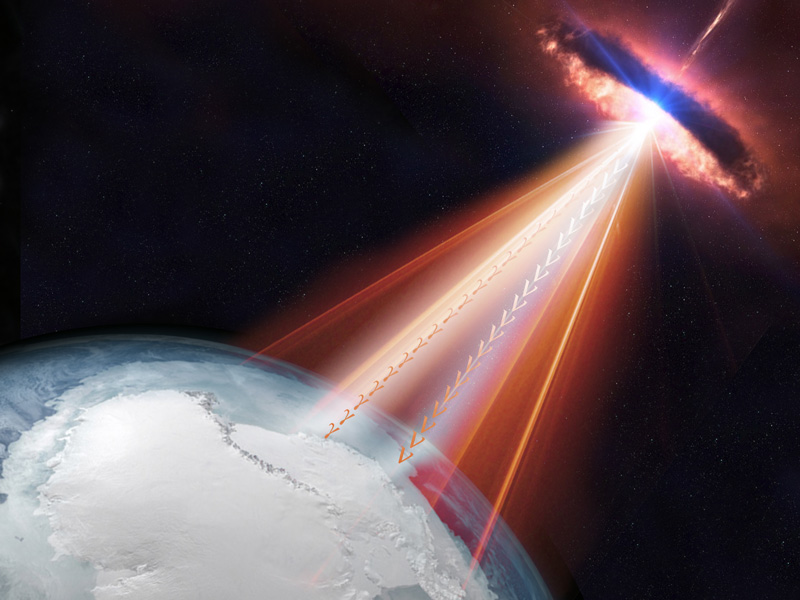

Mystery of the ‘ghost particles’ solved
Photos and illustrations courtesy of South Pole Group, Science magazine, IceCube/NASA July 12, 2018
Scientists trace high-energy neutrinos to galactic source for the first time
An international science team that includes researchers from the University of Delaware has found the first evidence of a source of what astronomers call "ghost particles”—high-energy neutrinos that can travel unhindered for billions of light years from the most extreme environments in the cosmos to Earth.
The observations, made by the IceCube Neutrino Observatory at the Amundsen–Scott South Pole Station and confirmed by telescopes around the world and in space, help answer a more than century-old riddle about what cataclysmic forces can send neutrinos and cosmic rays—particles smaller than an atom—speeding through the universe nearly as fast as light.
Two papers publishing July 13 in the journal Science point to a giant galaxy containing a “blazar” as a source of high-energy neutrinos detected by the National Science Foundation-supported observatory. This blazar, designated by astronomers as TXS 0506+056, was first singled out following a neutrino alert sent by IceCube on Sept. 22, 2017. The first paper explains the new discovery and the second paper shares information from observations made over the past 10 years that supports these conclusions.
“This is the smoking gun,” said Thomas K. Gaisser, Martin A. Pomerantz Chaired Professor of Physics and Astronomy at UD. “Active galaxies have always been the leading contender for producing high-energy cosmic rays and neutrinos, but we didn’t have the evidence until now.”
Equipped with a nearly real-time alert system—triggered when a very high-energy neutrino collides with the nucleus of an atom in the Antarctic ice in or near the IceCube detector—the observatory broadcast coordinates of the Sept. 22 neutrino alert to telescopes worldwide for follow-up observations.
Other observatories, including NASA’s orbiting Fermi Gamma-ray Space Telescope and the Major Atmospheric Gamma Imaging Cherenkov Telescope, or MAGIC, in the Canary Islands, detected a flare of high-energy gamma rays associated with TXS 0506+056, further implicating the blazar as the most likely source.
For the scientists, it was a bit of a surprise.
“It wasn’t in the list of potential sources we were looking at,” Gaisser said. “This one never popped up before.”
The cosmic ray connection
The IceCube team refers to blazar TXS 0506+056 as “Texas.” You’ll find it in the night sky just off the left shoulder of the constellation Orion about 4 billion light years from Earth.
A blazar is a supermassive black hole—with material whirling around it, and huge jets of material bursting from it—at the center of an elliptical galaxy. Millions of times the mass of the sun, the black hole sucks in matter when it is actively accreting, and twin jets of light and subatomic particles blast out from the poles along the axis of the black hole’s rotation. One of the jets of blazar TXS 0506+056 points at Earth.
“The connection of these jets to high-energy cosmic rays is of great interest to us,” said Gaisser, who comes from a distinguished line of particle physicists at the Bartol Research Institute in the UD Department of Physics and Astronomy.
The late Martin Pomerantz, Gaisser’s mentor and former Bartol Institute director, pioneered astronomy and astrophysics research in Antarctica. This harsh environment is an ideal place for such studies because cosmic rays can enter at the poles unimpeded by Earth’s magnetic field.
Since they were first detected over one hundred years ago, cosmic rays—highly energetic particles that continuously rain down on Earth from space—have posed an enduring mystery: Where do they come from?
Because cosmic rays are charged particles, their paths cannot be traced directly back to their sources due to the strong magnetic fields that fill space and warp their trajectories. But the powerful cosmic accelerators that produce them may also produce neutrinos.
Neutrinos are uncharged particles, unaffected by even the most powerful magnetic field. Because they rarely interact with matter and have almost no mass—hence their sobriquet “ghost particle”—neutrinos travel nearly undisturbed from their accelerators, giving scientists an almost direct pointer to their source.
“The era of multimessenger astrophysics is here,” said NSF Director France Córdova. “Each messenger—from electromagnetic radiation, gravitational waves and now neutrinos—gives us a more complete understanding of the universe, and important new insights into the most powerful objects and events in the sky. Such breakthroughs are only possible through a long-term commitment to fundamental research and investment in superb research facilities.”
World’s largest particle detector
Spotting the highest energy neutrinos requires a massive particle detector, and IceCube is by volume the world’s largest. Encompassing a cubic kilometer of deep, pristine ice a mile beneath the surface at the South Pole, the detector, which UD scientists helped build, is composed of more than 5,000 light sensors—on 86 cables on a grid with a spacing more than the length of a football field.
When a neutrino interacts with the nucleus of an atom, it creates a secondary charged particle, which, in turn, produces a characteristic cone of blue light that is detected by IceCube and mapped through the detector’s grid of photomultiplier tubes. Because the charged particle and light it creates stay essentially true to the neutrino’s direction, they give scientists a path to follow back to the source.
Following the Sept. 22 detection, the IceCube team quickly scoured the detector’s archival data and discovered a flare of over a dozen astrophysical neutrinos detected in late 2014 and early 2015, coincident with the same blazar, TXS 0506+056. This independent observation adds to a growing body of data that indicates TXS 0506+056 is the first known accelerator of the highest energy neutrinos and cosmic rays.
The IceCube Collaboration, with more than 300 scientists in 49 institutions from around the world, runs an extensive scientific program that has established the foundations of neutrino astronomy. Their research efforts, including critical contributions to the detector operation, are funded by agencies in Australia, Belgium, Canada, Denmark, Germany, Japan, New Zealand, Republic of Korea, Sweden, Switzerland, the United Kingdom, and the United States.
Contact Us
Have a UDaily story idea?
Contact us at ocm@udel.edu
Members of the press
Contact us at 302-831-NEWS or visit the Media Relations website




